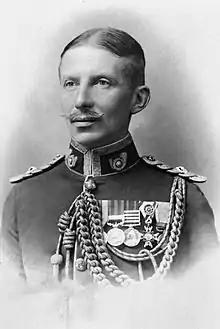Charles Allix Lavington Yate
Major Charles Allix Lavington Yate, VC (14 March 1872 – 20 September 1914) was an English British Army officer and recipient of the Victoria Cross, the highest and most prestigious award for gallantry in the face of the enemy that can be awarded to British and Commonwealth forces.
Charles Allix Lavington Yate VC | |
|---|---|
 | |
| Born | 14 March 1872 Ludwigslust, Grand Duchy of Mecklenburg-Schwerin, Germany |
| Died | 20 September 1914 (aged 42) Torgau POW camp, Kingdom of Prussia, Germany |
| Buried | Stahnsdorf, Berlin, Germany |
| Allegiance | |
| Service/ | |
| Years of service | 1892 - 1914 |
| Rank | Major |
| Unit | The King's Own Yorkshire Light Infantry |
| Battles/wars | |
| Awards | |
| Relations | Sir Charles Yate, 1st Baronet (cousin) |
Yate, from Madeley, Shropshire, attended the Royal Military College, Sandhurst, and joined the British Army. He saw service in British India, Mauritius, South Africa during the Second Boer War, as an observer during the Russo-Japanese War, and between 1908 and 1914 he was on the staff of the War Office in London.
Early life
Yate was born in his mother's home town of Ludwigslust on 14 March 1872 to the Reverend Prebendary George Edward Yate (1825–1908), vicar of St Michael's Church, Madeley from 1859 to 1908, [1] and his German second wife Luise Caroline Georgine Adolphine Henriette, née Petersen. His cousin was Sir Charles Yate, 1st Baronet.
He was educated at Weymouth College, and graduated from the Royal Military College, Sandhurst, 9th out of 1,100 cadets. He joined the 2nd Battalion, the King's Own Yorkshire Light Infantry as a second lieutenant on 13 August 1892, while it was stationed in Bombay.[2] Promoted to lieutenant on 7 January 1894, he first saw action in India in the Tirah expedition from 1897 to 1898, for which he was awarded the medal and clasp of the Tirah Expedition.[2] He was promoted to captain on 26 July 1899, and with his battalion was transferred to South Africa following the outbreak of the Second Boer War in October that year.[3] The battalion took part in the battles of Belmont and Enslin in November 1899, where Yate was seriously wounded.[1] After the war ended in June 1902, he transferred with the battalion to Malta, leaving Point Natal on the SS Staffordshire in October.[4]
On 17 September 1903 he married at St George's Church, Hanover Square, London,[5] Florence Helena Brigg, from Greenhead Hall, Yorkshire.[1][2] There were no children.[1][2]
He was promoted to the rank of major in 1912.[1] Yate was fluent in French, German and Japanese, and could also speak Hindustani and Persian.
VC action
Yate was 42 years old, and a major in the 2nd Battalion, The King's Own Yorkshire Light Infantry, during the First World War when the following deed took place during the battle of Le Cateau for which he was awarded the VC.
On 26 August 1914 at Le Cateau, France, Major Yate commanded one of the two companies that remained to the end in the trenches, and when all other officers had been killed or wounded and ammunition exhausted, he led his 19 survivors against the enemy in a charge.[6]
He was captured by the Germans and interned in Targau prisoner of war camp. After repeated attempts, he escaped a month later on 19 September 1914, but was quickly apprehended by local factory workers who suspected his appearance, and cut his own throat to avoid recapture and possible execution as a spy.[1][7][2] He died on 20 September 1914.
Four other VCs were won that day at Le Cateau, including one by Lance Corporal Frederick William Holmes,[1] who wrote of Yate: Major Yate was a thorough gentleman and a great favourite with us all. He had had a lot of experience in the Far East and at home, and I am sure that if he had lived he would have become a general. He was always in front, and his constant cry was "Follow me!"[5]
Yate is buried in grave II. G. 8.[8] at the Commonwealth War Graves Commission Berlin South-Western Cemetery in Stahnsdorf, near Potsdam, Germany.[7] He is also listed on the parish war memorial, now on The Green, at Madeley,[5] and within St Michael's Church, Madeley.[9]
The medal
His Victoria Cross is displayed at the King's Own Yorkshire Light Infantry Museum in the Doncaster Museum, England.[10]
References
- "Madeley's VC - Major C.A.L. Yate". Archived from the original on 19 September 2007. Retrieved 15 April 2008.
{{cite web}}: CS1 maint: bot: original URL status unknown (link) - VC winner's, Ys
- Hart′s Army list, 1903
- "The Army in South Africa - Movements of Troops". The Times. No. 36896. London. 11 October 1902. p. 10.
- Francis, Peter (2013). Shropshire War Memorials, Sites of Remembrance. YouCaxton Publications. p. 142. ISBN 978-1-909644-11-3.
- "No. 28985". The London Gazette (Supplement). 24 November 1914. p. 9957.
- "Queen honours forgotten war hero". BBC News. 4 November 2004. Retrieved 28 March 2008.
- Casualty Details, CHARLES ALLIX LAVINGTON YATE
- Shropshire War Memorials, Sites of Remembrance. p. 143.
- List of KOYLI medals held in the Regimental Museum
- Monuments to Courage (David Harvey, 1999)
- The Register of the Victoria Cross (This England, 1997)
- VCs of the First World War - 1914 (Gerald Gliddon, 1994)